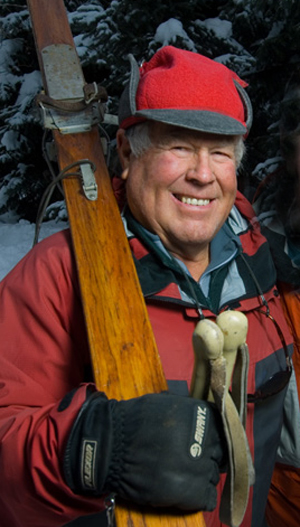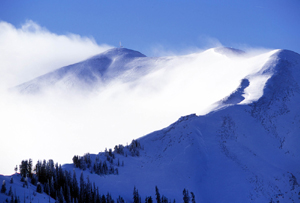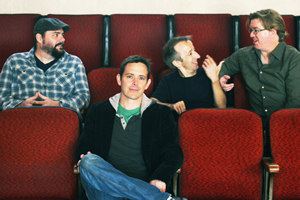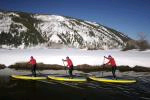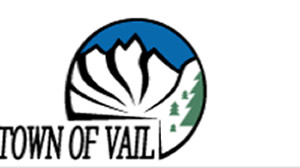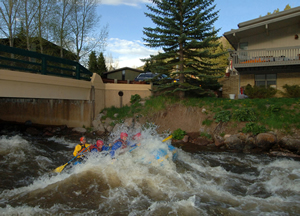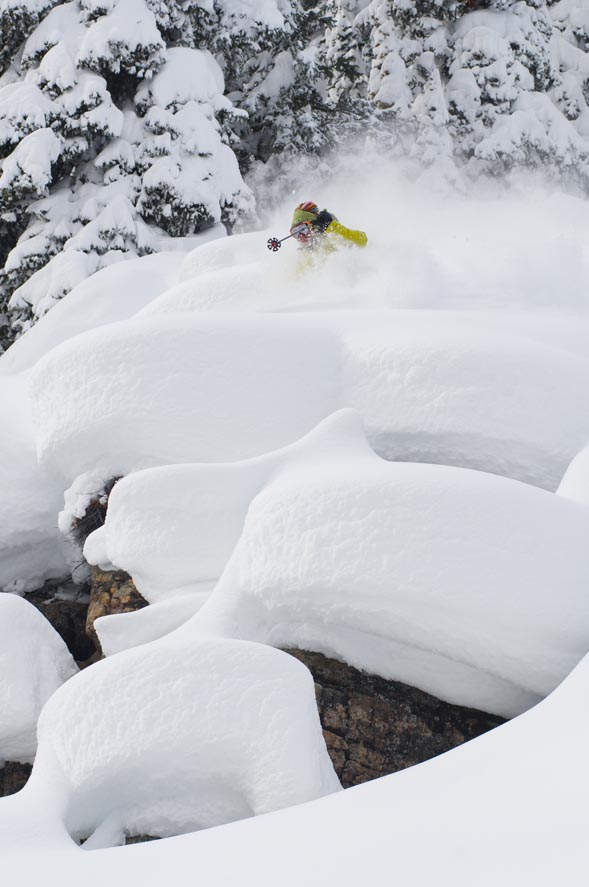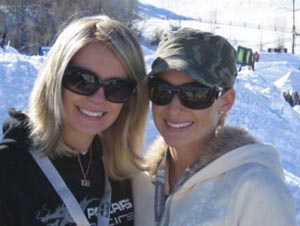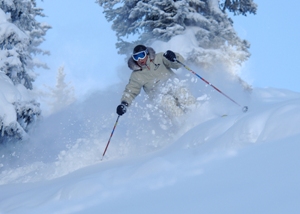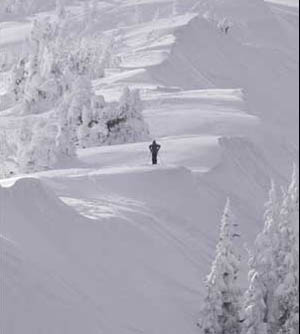The great sheep rescue
December 24, 2008 —
There are incessant innuendoes regarding man’s relationship to sheep, none of which escaped our notice on a stormy fall day in 1963, when a group of Vail’s “finest” ski patrolmen became involved in helping a band of sheep from certain death.
The sheep had been caught by a series of late fall snowstorms at higher elevations, before they could reach the main valley floor and relative safety. Even though this rescue contained practical applications – especially to their owner, Allen Nottingham, the whole thing was actually one huge publicity stunt for Vail Associates. It was contrived by who-knows-who in order to get the Denver Post writers and photographers up to Vail to produce another story on our town – this time with a slant on the fun and unusual side of our neophyte ski area – rather than the typical straight story on the fabulous powder skiing.
Allen, a truly terrific guy (and local rancher) had a genuine interest in learning what skiing and ski areas were all about. We patrolmen were always happy to help him learn to ski better, and since he already knew how to drink, he soon became one of the “the boys.” At that time, patrol was a loose-knit fraternity of sorts, but without the ordinary constraints of decorum – especially after sweep. We all became kings of the hill, if you will. Soon after this sheep rescue, for example, some of us got into elk hunting, many an adventure and escapade involving hunting with Allen could be told about our times up in the Beaver Creek area long before there was any development.
Allen, who was a pilot with a small, single-engine plane, had spotted his sheep, and in fact was somehow able to free-fall some bails of hay to his surviving sheep to keep them going. As I recall, they were located near the head of June Creek just below tree line.
The appointed day came, the press arrived, and a few of us in complete ski patrol regalia backcountry skied or were towed up on some sort of a snow cat. The snowcat itself was probably an improvisation of Vail “finder” Earl Eaton’s, one of the kind for which he was so famous, or maybe an old Army “Weasel” like the one we once drove to Deep Lake, high in the Flat Tops, for an ice fishing expedition on another occasion – but I digress.
After a couple of hours behind this makeshift snowcat, struggling up an old jeep road covered with several feet of snow, we arrived at a point where everyone had to put on their skis and hike a bit to get to where the stranded survivors were. Allen, of course, was our guide, since he knew the country forward and backward, and he brought us to the right spot – almost like a small corral – where the sheep had decided to camp out and stomp down the many feet of snow.
It was difficult to estimate how many surviving sheep were left, maybe 20 or 30. Layers of dead sheep were scattered throughout the clearing along with hay, snow, more dead sheep and more hay. The survivors seemed content to walk about and huddle together on top of their less-fortunate brethren and sistren.
Pictures were taken, notes were written, and it was all-in-all a great day for another adventure. I think we actually dragged in a bale or two of hay – just to make it realistic for the newspaper – but no sheep were actually herded out by us that day. We did pack out a small trail in the snow back to the “cat-weasel” so that within the next day or two, Allen was able to herd out the survivors.
The coyotes, ravens, and magpies must have had a field day!
After we got back to town, as any self-respecting patrolmen would do, we naturally had to critique the day’s heroics over many pitchers of beer and shots of whatever in one of Vail’s only three bars – most likely the downstairs dungeon of the Red Lion. It was an unwritten rule that we sequestered ourselves down there, away from most of the general public.
In the morning, bleary-eyed and all, we went up the mountain to herd and protect a different brand of “sheep” although I admit – and I can’t emphasize this enough – that in general the skiers of the 50s, 60s, and even 70s were much more self-reliant, independent and competent in taking care of themselves. There really wasn’t that atmosphere of pampering, catering, and wimpy-ism that is so prevalent around modern day ski areas. There was simply the overriding joy and enthusiasm for skiing that precluded everything else. To be a competent skier in all conditions was a truly athletic and not very easy endeavor. No offense to local management and the marketing people, but that is just one of the ways skiing and the skiers themselves have changed over the years.
One thing that hasn't changed, however, is Vail's creative ways to get itself in the paper - perhaps there aren't any sheep rescues anymore, but there is always something going on in Vail.
![]() Submit a comment on "The great sheep rescue"
Submit a comment on "The great sheep rescue"
Photo by Dan Davis trekkerphoto.com
As waters rise, some guidelines for increased river safety
June 21, 2008 —
Rivers are reaching their peak right now, which has led the sheriff to consider closing the rivers. In theory, he can close the river to rafts and commercial outfitters, but not to kayaks and whitewater canoes – something I know first-hand because Rick Winkeller and I were arrested in 1979 for kayaking a "closed" river (the Eagle).
But I had done my research beforehand. I knew there was an exception for kayaks and whitewater canoes in the Colorado statute, and myself and Rick took our case all the way to the Colorado State Supreme Court. In 1982 we won our case, and the sheriff, to this day, cannot close the river to us.
I’ll tell that story in my next entry, but in the meantime there are a few things I recently brought to a meeting with Eagle County Sheriff Joy Hoy June 10 to talk to him about river closures and river safety.
We had a constructive meeting and discussion, and I gave him a copy of a few ideas I have on the subject, which I've posted below.
Please use the comment function at the end of this story to add your own thoughts and ideas, too.
Some Guidelines for Increased River Safety
- Life Jackets (personal flotation devices) MANDATORY
- Thermal protection and helmets HIGHLY recommended
- Understand your own limitations as well as the limitations of your watercraft
- Employ the “buddy” system in more difficult waters
- Understand the implications of river ratings using the international scale (1-6), river gauges, and cubic-feet-per-second
- Understand other factors of reading water, such as water temperature, and if the water is continuous or pool drop
- Scout the river sections you are going to run if you are unfamiliar with them
Other notes:
- The two river features that have been flipping rafts, ironically, are either man-made or man-altered.
- Kayaks have the potential to “roll up,” rafts do not
Any other suggestions from the boating community are welcome.
![]() Submit a comment on "As waters rise, some guidelines for increased river safety"
Submit a comment on "As waters rise, some guidelines for increased river safety"
By Dan Davis trekkerphoto.com
Avalanche adventures and escapades
February 20, 2008 — “Louie!” Don shouted above the howling wind and ensuing ground blizzards. “Move to your right a little bit!”
Gingerly, Louie obliged, not being able to clearly discern where the edge of the cornice was. He knew very well, however, that somewhere to his left was a 50-foot vertical drop-off. After sliding lightly about 100 feet along the top of the ridge, constantly aware of the gravity of the situation, there came loud, dull, “CRACK” − a kind of muffled explosion.
The cornice which laced the top of Aspen Highlands Bowl had broken off in roughly an 80-foot horizontal section. Louie looked back and saw a gaping hole about 10 yards from the ski tracks behind him. The huge chunk of cornice had started an avalanche of substantial magnitude down one of the steepest parts of Highlands Bowl (and it’s all steep).
This particular section was so steep, in fact, that it rarely held much snow. The slide continued down over a rock island and into a narrow, constricted part of the lower bowl, just above Castle Creek.
“Wow, thanks,” said Louie.
He could see his tracks leading into an abyss and, fortunately, continuing out the other side. That was 1960, but it was a sight Louie has never forgotten to this day.
Being caught in an avalanche of that kind may or may not have buried, i.e. killed, Louie, but it would’ve been a nasty ride with very high potential for injury. There had been huge blocks of snow, and it would have been an extremely difficult rescue because of the continued slide potential. There weren’t any high-altitude helicopters back then.
Most people would have aborted their trip at this point, but not the intrepid Louie and Don Krumm. After all, they were ski patrolmen with some vague sense of knowledge and certain awareness of avalanche potentials. Besides, their plan was to traverse up and around the main part of Highlands Bowl to the more northerly exposure, where trees offered protection with some skiable slots, and where there were no cornices and wind build up.
This wasn’t Louie’s first trip up Highlands Bowl. Louie had skied it with a different friend in May of 1958, when the snow that was going to slide, theoretically, probably had already slid and therefore the snow was relatively cohesive and stable. It was a demanding hike from the base of Highlands ski area to the top of Highlands Peak, over 4,000 vertical. The plan on that particular trip was to ski right down the gut, atop the old slide debris and over Castle Creek via the snow bridge created by the continuous avalanches.
On that first venture, just before reaching the summit, one of Louie’s skis totally de-laminated (probably an old Head standard or vector ski) but with the help of some parachute cord and tape repairs, he continued on. They plunged off, by far, the steepest thing they had ever skied. The snow held, the skies could grab a purchase on the nice, 2-4 inches of corn snow of the easterly exposure, and it was a successful and exhilarating ski down. It was so steep in places Louie could stand and comfortably touch his hand to the wall without leaning over.
(NOTE: On a later trip up Conundrum, with Paul Worth, who lived at and ran the sundeck on Ajax Mountain, Paul mentioned that Louie and whomever his buddy was, probably were the first people to ever ski Highlands Bowl.)
In the early 1980s three patrolmen were killed in a massive slide that, unpredictably, started on the southeast shoulder of Highlands Peak, which was a lot less steep in that particular location. Sepp Kessler’s son was one of them, I don’t recall who the other two were. But it proved that, then and now, there is absolutely no “for sure” ability to predict, with any degree of certainty, what avalanches are going to do. Another example: there was what they call a soft, spring slab slide that killed an individual in A-Basin in spring of 2005.
Now Highlands Bowl is open to the general skiing public, and is accessible partway by lift, partway by snowcat, and the rest by hike. Volunteers and patrolmen boot-pack the slope each year to improve snow stability. That does not mean, however, that it is 100 percent avalanche proof.
Whenever a death occurs in this day and age the tendency is to point the blame at someone. Sometime in the heavy El Nino years of ’83 and ’84, someone who had lost loved ones to an avalanche actually tried to sue the Forest Service for not keeping the backcountry safe. Fortunately that lawsuit was thrown out before it ever went to court.
That kind of litigation would never have been considered in the days when Louie had his first encounter with avalanches. It was springtime, and Louie was endeavoring to embark on the first of many trips up the Conundrum Valley to the natural hot springs and cabin which awaited about 10 miles south-southwest of Castle Creek.
Spring slides were still active at that time, and Paul Worth had observed from his perch at the sundeck that they hadn’t all come down. Of course, Louie went anyway. On the way up he witnessed several more avalanches cascading down the valley walls, particularly during the hot part of the day. Being spring slides, they flowed in relative slow motion, complete with dirt, trees, and piles of brush mixed in.
Definitely a concern!
During the following summers, Louie continued to be duly impressed with the power and magnitude of avalanches. On the way up Conundrum Valley, he observed huge snow bridges covering over Conundrum Creek − even in late August, and noted there were slide paths from either side of the valley that joined together in the center. These avalanches would have started from above treeline at 13,000 to 14,000 feet.
Definitely not a good place to be at the wrong time!
After a couple of ski-bumming seasons Louie hired onto the Highlands Ski Patrol, where avalanche control and encounters were part of the job description − and a pretty exciting one at that.
In those days, one of the methods for mitigating avalanche danger was “ski cutting” or “criss-crossing,” potential avalanche zones. Ski cutting was when a patrolman would ski into the top of a slide path and try and set off the avalanche that way – without getting caught in it. If it didn’t slide on top when you tried to set it off, then you’d “criss-cross” the snow below, with kick-turns and traversing, in an attempt to stabilize it.
We also used explosives. Fun, fun, fun! But potentially dangerous.
It wasn’t real scientific then, but is it now?
Isn’t there always a probability or possibility factor?
There’s always the unknown when it comes to dealing with avalanches.
We were so casual about slides at Highlands that we used to make bets as to whereby a particular slide would occur. For example, one morning everything was moving pretty well because of the depth-hoar, or sugar snow, and I was instructed to take out a rookie on a particular avalanche route. The plan was to ski-cut the top of a potential slide, and the objective was to not get caught up in it.
So I told Carl, a rookie fellow patrolman, “Whatever you do, don’t tip over downhill. Lean back against the hill.”
We skied the gentle part of the slope to gain some momentum, and simultaneously cut into the snow with a hard turn to hopefully induce a slide.
Guess what?
Somehow Carl tipped over downhill and went down with the ensuing slide. It ran about 300 yards down the hill, but fortunately he was on top as the slide went down.
He ended up partially buried, but in the process he fractured an ankle. I stood there on top of the fracture line, kept an eye on him, and realized I couldn’t ski down to him because the slide had climaxed clear to the ground. In those days we didn’t have radios, either, so he couldn’t call for backup. Another team of two was in the area, traversed in and got to him.
Carl ended up on phone duties (aka dispatch) with a cast on his ankle, and we got to fooling around with his bindings. We figured they had a lot to do with his injury. His set up included a Marker Simplex toe-pieces and long-thong heels (we always used long-thong heels). Even with the spring and ball removed from the bottom, Carl’s toe-pieces had to be beat open with a hammer because they were corroded shut.
Using dynamite and other forms of explosives was a whole and other adventure as well. At Aspen Highlands the ski patrol Director, Chuck Bolté, an ex-Ajax patroller, bought all kinds of different, over-the-counter explosives to save money, including ditching dynamite, seismograph charges, and any other thing that was cheap. Some of the aforementioned were even leaking gelatin, which was rather unstable. Unlike most ski areas, which hired their own ski patrol, Aspen Highlands owner “Clip” Jones contracted the ski patrol to Chuck Bolté.
Chuck’s motivation was to save money, and that meant that the ski patrol were asked to do all kinds of various tasks − we even made our own toboggans and ski roller-packers.
Louie was assistant patrol director because he cared. This title also earned him all kinds of unique assignments. One day Chuck got the brilliant idea of riding up the chairlift with the made-up caps and fuses and Louie carrying about 40 pounds of seismograph charges in an old army pack-sack.
Louie and Chuck left instructions for the lift attendant to stop the lift halfway up what was then called “Stein Erikson’s” run on a hand signal while the patrolmen fired up a couple of charges and threw them off the lift, up the slope to the left. This was done, and all was well, until the duo realized the liftie wasn’t paying attention. He didn’t see the increasingly frantic hand signals to start the lift and take them out of the blast zone.
With about a five minute fuse Louie was getting ready to jettison the dangling backpack because there was the distinct possibility that the eminent blast would set off a sympathetic reaction to the rest of the charges in the backpack.
Finally, after a short eternity, the lift slowly started moving.
Whew! Double whew!! And triple whew!!!
It was 1962 that Louie first skied Vail and realized that the powder skiing was fabulous, fantastic, and incredible.
A year later he moved to Vail to be on ski patrol. What a different world!
The powers-to-be wanted to do things right. Aspen was old-fashioned, and refused to change, whereas Vail was very progressive. There were new innovations in every aspect of skiing, from ski patrolling to ski area management. Everyone also wanted to do things right − and in a more safe environment.
For example, Louie even made up the blasting caps at the opposite end of the table from the made-up the HDP charges used then. In Aspen, patrolmen had no ignition lighters so matches were used instead. Vail’s pull-tab fuse lighters were much more effective, especially in the howling wind.
Most patrollers also carried “avalanche cords,” which is parachute cord dyed orange and with foot-markers indicating length. The idea was that, if someone got buried in an avalanche rescuers could follow the cord to the victim. Some patrolmen insisted on using them, and insisted anyone else they worked with also used one. Louie questioned the effectiveness of the cords, however, because of the fact that no one carry shovels.
(NOTE: Although it was never tested, some patrolmen felt they could self evacuate from a chairlift with a double-strand of parachute cord.)
That is not to say there were no incidents involving slides and ski patrolmen. Numerous areas on Vail Mountain have been named for the various patrolmen who were involved in slides there, none of whom found the experience fatal.
For example, Cambpells is named after Vail’s first forest ranger; then there’s BJPT’s, Fritz’, later on Hinman’s … and many others. Kangaroo cornice was named after Captain Kangaroo, Vail’s second assistant patrol director, which never slid or even cracked despite the fact that patrol consistently blew big gaping holes in it. It was fun to blow things up, Louie thought, but in his humble opinion actually a waste of good explosives.
In those days senior patrolmen were appointed various duties to specialize in areas of patrolling, avalanche, phones (the old magneto system adapted from WWII), first aid, lift evacuation, and toboggans (including jake tables, etc).
One of the more fun and interesting things on patrol (and the patrolmen were definitely into fun) was to volunteer for overnight avy duty. This involved four or five patrol staying up overnight at the old Patrol Headquarters (PHQ) building, with the theory being that patrollers would make up the charges, blasting capt etc. and set them aside separately until the next morning. Then they would start out at first light to go on the various avy routes. Avalanche control in Vail was a little more complicated than it was in Aspen because Vail had such expansive, wide-open areas in the Back Bowls. Certain areas in Vail also received an awful lot of wind deposit, which creates a separate set of unpredictable problems. The control work would hopefully be completed well before the skiing public got on old Gondola 1, which ran up out of the village to mid-Vail and subsequently chair 4. Sometimes, toward the end of a storm cycle, patrol would not be able to even find their control routes because of white-out conditions. In these cases the backside would be closed (Sun Up and Sun Down) because if the public were allowed back there we probably wouldn’t find them until the following spring.
Just to put it in perspective to modern-day skiers, there was a hard and fast rule back then that you did NOT ski the backside alone.
In general the theory of overnight avy duty, worked and helped patrol keep the backside open as much as possible. However, patrolmen being what they were, they thought they could turn this overtime duty into a huge party complete with extra food, booze, and girlfriends were known to in the woods until after super-sweep left. Then the party would begin. Again, on more than one occasion, particularly on moon-lit nights, lifts were started, patrolmen and sometimes girlfriends would go skiing. The lifts were just left turning – hopefully no-one got stuck on them. Talk about mystical skiing, what with moonlight, headlights, plenty of beverages, etc.
All too often on these overnight excursions, the appointed patrolmen were kinda slow to get out and about the following morning. Often chair 4 was already turning when the patrol left to head out on their routes.
On one memorable occasion Louie and John Simms left PHQ, fully loaded, and I don’t mean just with explosives. They went out to the Apres Vu and Chicken Yard route. It was a beautiful day. A recent series of storms had cleared out, leaving frost hanging in the air, we had had the backside closed for two or three days, and a few sun-dogs came through the mist.
Standing above the lee side of High Noon Ridge, Aprés Vu, they pulled the igniters and tossed two simultaneous charges about 35-40 yards over the huge wind-deposit area hovering skier’s right of the main slot.
The blasts went off and a massive fracture line zippered over to the west, across the top of Chicken yard, into the trees on the other side of Chicken Yard and almost to Chair 5.
The ensuing snow plume was something to behold, and we saw even more evidence of the magnitude of this slide later, while shoveling a pathway through the debris. The slide had gone so far as to take out the emergency phone on its way over the Sunup catwalk and partway up the other side of the valley into the trees. To this day it may be one of the biggest slides ever set off intentionally on Vail Mountain. It was a beautiful sight from our perspective, standing 30 yards from the fracture line.
Even then it was a proven fact that it doesn’t take a very large slide to bury someone, something we never wanted to have happen – with the majority of people anyway.
“Fire in the hole” patrol would yell as they through the bombs as far from themselves as they could, and then here would come P.P. Grasshopper, Vail’s un-“official” “Ambassador” of skiing. He would come skiing right through our enclosures, entourage in tow, while we were doing control work. This happened to patrolman on more than one occasion.
“You guys don’t know what you’re doing!” He would yell “This should be open!” in that abrasive, arrogant, Austrian accent. In our meetings with Pete, we constantly tried to control P.P. and complained about him all the time hoping he would one day get caught in a slide, not buried totally, but just enough so that he would develop a little respect. Not necessarily for the patrolmen, which he would never do, but for the slide potential on Vail Mountain.
Nowadays things have changed considerably because all the bowls and all the little off-piste areas are skied so much more than they used be so that, except for wind deposit, the area is pretty safe. The amount of traffic stabilizes the snow pack and helps minimize any depth-hoar build up. The present-day approach to avalanches is much more scientific, the layers are studied, etc, although in the old days, as they do now, patrolmen were sent to avalanche schools in different parts of the Western United States.
But the bottom line is, as with most naturally-occurring forces, it is still basically unpredictable. There really are no avalanche experts … they’re all dead.
As with almost all natural phenomena, and unnatural phenomena, it pays to be somewhat observant and aware − as well as just plain lucky.
Louie still has a great deal of respect for this naturally unpredictable force, and still jumps with that shot of adrenaline whenever he is in the backcountry and the snow settles with a big “WHOMPH” − even on the flats.
Recommended reading: Snowstruck; In the grip of avalanches by Jill Fredston
![]() Submit a comment on "Avalanche adventures and escapades"
Submit a comment on "Avalanche adventures and escapades"
By Dan Davis trekkerphoto.com
Mother Almond ... continued
January 28, 2008 — continued...
And on another occasion, Mother came up to PHQ and announced that we all should become Karate experts, as a self-defense mechanism in case of a spring riot. Lo and behold he executed a karate chop on one of the hollow-core doors, punching a hole right threw it.
Then turned to me and said, “Louie, you can fix that, can’t you?”
To which I replied, “Sorry Mother, I just don’t do carpentry work in the wintertime.”
His collection of stories from the early days of Vail and Aspen, called "The Understories", are being serialized on realvail.com.
To read The Understories from the beginning, scroll to the bottom of this page and read from his first entry, "The Introduction."
Despite our constant ribbing of Mother (or “granny,” as I began calling him), he and I shared in common that we had both patrolled at Aspen, where the jumps and the terrain were a bit more wild than Vail. Mother knew I had been part of the Aspen Highlands patrol which attempted to emulate the great Stein Erickson’s inverted-air front flips. These jumping shows grew to become popular crowd pleasers, I suppose because of the fairly commonplace, and spectacular, crashes.
A couple of the patrol, one in particular named Earnst Kapelli, got fairly consistent at sticking the landing; but not Louie.
There was another notable jump in Aspen Highlands we used to jump called the “whoopee” jump. When I came to Vail we made a jump under the Chair 4 cliffs and dubbed it the “whoopee” jump in memory of the old Highlands jump, but in my opinion Vail’s whoopee was not nearly so dramatic.
It was during the maintenance of the whoopee that Mother and I began our long-running banter back and forth about the relative merits of sculpting and shaping jumps on Vail Mountain. One of the things I’m sure was totally exasperating to Mother was when I brought out the 100-foot tape measure so that landings could be marked out in 10-foot increments.
In spite of Mother’s vehement protests, only one substantial injury comes to mind … when Chuck Malloy approached the waterfall jump with a little too much speed, out-jumped the landing (well over 100 feet), and landed in the flats with a subsequent cracked angle.
Not bothered by this, I built a kicker atop the Chair 4 cliffs.
That’s when Mother came to me and said, “Louie, aren’t you getting a little too old for this?”
To which I replied: “At least I wasn’t always old.”
![]() Submit a comment on "Mother Almond ... continued"
Submit a comment on "Mother Almond ... continued"


